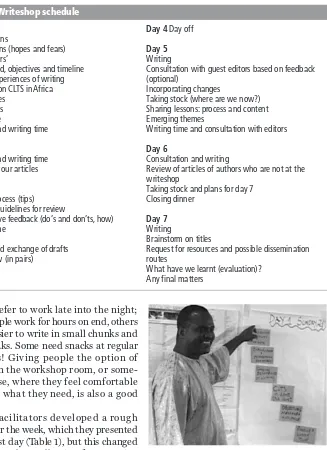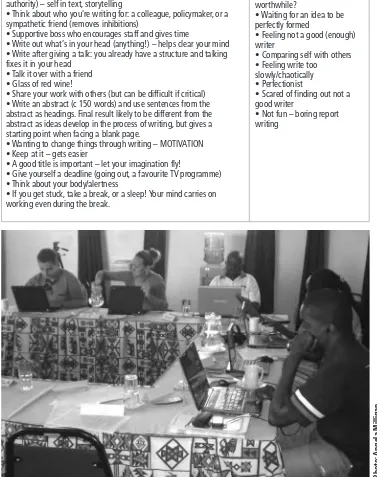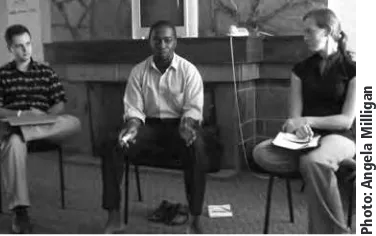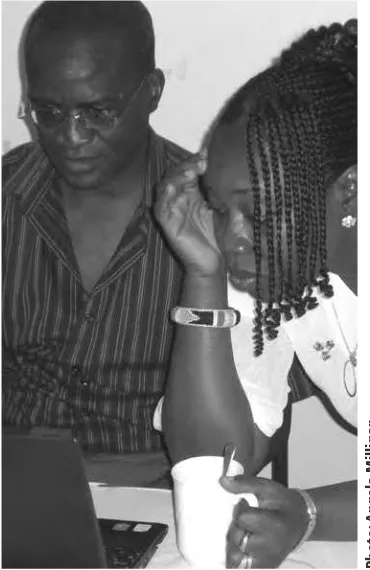Practitioners, particularly those from the South, face a range of barriers to sharing their learning and reflections with a wider audience. These include language constraints, time pressures and lack of experience and confidence in writing papers. These barriers are even more severe for women. This poses a problem for Participatory Learning and Actionbecause the experiences of practitioners, particu-larly those from the South, are exactly those we want to capture. Recently, we have been
experimenting with participator y
writeshopsas one way to support practi-tioners to contribute to themed issues.
For the Community-Led Total Sanita-tion (CLTS) issue of PLA, Plan Kenya, IDS and IIED held a one-week writeshop in Nairobi, Kenya. This Tips for trainers describes the CLTS writeshop, draws together some lessons for running success-ful writeshops, and discusses some of the challenges associated with writeshops.
Prior to the writeshop
The CLTS in Africa issue of PLAwas
initi-ated over a year ago, following discussions with Petra Bongartz and Robert Chambers from IDS and Samuel Musembi Musyoki from Plan Kenya. Petra and Samuel submitted a concept note which set out why an issue was needed, what it would cover, and the process to be followed, which included a writeshop to bring together practitioners. Petra and Samuel then circu-lated a call for contributors to a pre-selected list of CLTS practitioners, and asked them to submit 500-word abstracts. The final contributors were chosen and sent a timeline for the writing process. Authors were asked to submit at least a first draft of their article before the writeshop, and these were circulated to the other participants beforehand. This included some drafts by authors who could not attend the writeshop.
Objectives of the writeshop These were to
• Reflect on the writing process
• Release participants’ capacity to docu-ment
by ANGELA MILLIGAN and PETRA BONGARTZ
Let’s write! Running a
participatory writeshop
• Provide mutual support and peer review • Improve and work further on articles • Draw out common threads to feed into the overview for the themed issue
• Identify gaps in the content and consider how to fill them.
The writeshop participants
There were 11 participants at the writeshop, including three facilitators (Samuel Musembi Musyoki, Petra Bongartz and Angela Milligan). Grace Ogolla from Plan Kenya provided excellent logistical support, and David Ngige docu-mented the writeshop on video and in photographs. Robert Chambers also attended the first day of the writeshop, and shared his experience and tips on writing. The participants came from Zimbabwe, Zambia, Sierra Leone, Malawi, Kenya and the UK. There were five women (one from the South) and seven men (five from the South), with varying experience of writing. Most authors had hands-on experience in CLTS and were involved in managing or supporting sanitation programmes.
Location
Choosing the right location for a writeshop is important. We held ours at a quiet loca-tion, not far from Nairobi but away from any distractions. Being surrounded by nature, having quiet spaces away from the group, the option of working in one’s room and flexibility with meal times were all helpful to the writing process.
Facilitators/resource persons
We had three resource persons to share the facilitation and support authors in one-on-one sessions. We found that it was really helpful to have a non-CLTS specialist editor (Angela) at the writeshop, as well as the guest editors (Petra and Sammy) with expert knowledge on the theme of the issue. A non-specialist editor can spot where assumptions are being made about what readers will understand, and identify language and terms that need to be
defined. It’s also important to emphasise to participants that the role of the editor is to help authors get their message across in the best possible way to the reader.
Duration and agenda
The CLTS writeshop was a week long. This initially seemed excessive to many partici-pants, but at the end they all agreed that it really helped to have this amount of time to focus on their writing. It also allowed us to have a very light agenda with lots of open space, allowing people to have a whole morning or afternoon for writing where and how they wanted. We found that some people like to write early in the morning, Participants take part in an icebreaker on the first day (left to right: Giveson, Buluma, Mariama, Robert, Angela, Herbert).
Photo:
David Ngige
Cathy pulls together participants’ hopes and fears.
Photo:
David Ngige
Angela writing up guidelines for peer review.
Photo:
others prefer to work late into the night; some people work for hours on end, others find it easier to write in small chunks and have breaks. Some need snacks at regular intervals! Giving people the option of writing in the workshop room, or some-where else, some-where they feel comfortable and have what they need, is also a good idea.
The facilitators developed a rough agenda for the week, which they presented on the first day (Table 1), but this changed as we went along, allowing for emerging issues, questions and requests for assis-tance to be addressed. At regular intervals, we brought everyone back together to see how their writing was progressing and whether they needed support.
Writing
We spent quite a bit of time on the first and second days discussing writing. In one session, we all sat in a circle and shared our writing experiences, hopes and fears. This
was a great way of getting to know each other better. We thought about:
• Our experiences with writing • The challenges we face
• Our beliefs about ourselves as writers • What helps us to write
• What we do when we’re blocked • Our good and bad habits.
Most people found writing hard and felt Samuel presenting the agenda for Day 1 of the writeshop.
Photo:
David Ngige
Day 1 Introductions
Expectations (hopes and fears) ‘Shit matters’
Background, objectives and timeline Sharing experiences of writing PLA issue on CLTS in Africa • Objectives
• Messages • Audience
Reading and writing time
Day 2
Reading and writing time Presenting our articles
Day 3
Writing process (tips) Checklist/guidelines for review
Constructive feedback (do’s and don’ts, how) Writing time
Pairing up
Printing and exchange of drafts Peer review (in pairs)
Day 4 Day off
Day 5 Writing
Consultation with guest editors based on feedback (optional)
Incorporating changes
Taking stock (where are we now?) Sharing lessons: process and content Emerging themes
Writing time and consultation with editors
Day 6
Consultation and writing
Review of articles of authors who are not at the writeshop
Taking stock and plans for day 7 Closing dinner
Day 7 Writing
Brainstorm on titles
Request for resources and possible dissemination routes
What have we learnt (evaluation)? Any final matters
Workshop participants (right to left): Buluma, Mariama, Herbert, Ashley and Jean-François writing at their laptops.
Photo:
Angela
Milligan
What helps?
• Write regularly
• Find the right time for you – could be morning, middle of the night! • Carry a notebook to note down thoughts/ideas
• Prioritise writing: remember how important it is to communicate your work to the wider world
• Write from personal experience (much easier – you are the authority) – self in text, storytelling
• Think about who you’re writing for: a colleague, policymaker, or a sympathetic friend (removes inhibitions)
• Supportive boss who encourages staff and gives time
• Write out what’s in your head (anything!) – helps clear your mind • Write after giving a talk: you already have a structure and talking fixes it in your head
• Talk it over with a friend • Glass of red wine!
• Share your work with others (but can be difficult if critical) • Write an abstract (c 150 words) and use sentences from the abstract as headings. Final result likely to be different from the abstract as ideas develop in the process of writing, but gives a starting point when facing a blank page.
• Wanting to change things through writing – MOTIVATION • Keep at it – gets easier
• A good title is important – let your imagination fly!
• Give yourself a deadline (going out, a favourite TV programme) • Think about your body/alertness
• If you get stuck, take a break, or a sleep! Your mind carries on working even during the break.
Table 2: What helps and what hinders writing?
Challenges/inhibitors
• Trying to write and edit at the same time
• Not knowing what to share • Assuming what you know is common knowledge • Self-doubt: is this worthwhile?
• Waiting for an idea to be perfectly formed
• Feeling not a good (enough) writer
• Comparing self with others • Feeling write too
slowly/chaotically • Perfectionist
• Scared of finding out not a good writer
self-doubt at times. They had devised a wide range of strategies to encourage them-selves to write, or to make writing easier (see Table 2).
We also read an article on CLTS by Rose George (a journalist) and asked ourselves what made it so engaging and good to read, and what lessons we could draw for our own work. We then developed some tips on good writing, drawing on our analysis and the experience of the editors (Table 3).
Presenting the articles
Even though people had read each other’s articles prior to the writeshop, it was really useful to get people to present their article in an informal setting (we just sat in a circle). No one used PowerPoint or notes; they just spoke about their work, and then other participants asked questions or made comments. In some cases this really brought the articles to life and made it much clearer to us and to the authors what
No one is obliged to read your work – make them wantto! Write for your reader, not for yourself.
Be clear whoyou are writing for and what your key messages are. Grab your reader’s attention by having a great title and a strong introduction.
What should I include? Have an introduction: say briefly what your article is about but don’t summarise all your arguments. Whet your readers’ appetite and keep them wanting to read on.
Whatis important about this experience? Whatare the wider lessons? Whatwere the challenges and how did you overcome them? Be honest! Tell enough of the story to make sense and draw out the main lessons, but don’t include every detail and activity.
Make it personal: if you have really learnt from the experience you’re describing, put yourself in the article. You should always say what your role was in the process so that people know whose perspective this is (called ‘positioning’).
Make use of stories – they lodge in the consciousness.
How can I make it flow well? Having trouble with the structure? Write post-it notes of main points and move around until you have a logical flow from point to point. Use headings and sub-headings to provide structure and signposts for the reader.
Make your paragraphs flow by linking them, e.g. repeating words from the previous paragraph in the first sentence of the next paragraph.
How can I make it interesting? Break up the text! Use boxes (for
examples, short case studies, quotes, descriptions of methods) and use visuals (tables, figures, photos).
Make it come alive – include quotes from participants. Vary the length of your sentences, avoid very long sentences, and use questions.
Give examples. Write as you talk and be enthusiastic – let your own voice come through.
Use straightforward, clear, simple language (little jargon, few acronyms).
And finally …
Very important:acknowledge all those who contributed their experience, e.g. field workers. Even better, co-author with them. Keep going: writing is hard, but it gets easier with practise. Table 3: Writing tips
Ashley presents her paper, with (left to right) Herbert, Jean-François, Buluma and Samuel Rukuni looking on.
Photo:
Angela
Milligan
Buluma talks about his paper with Jean-François (left) and Ashley (right) listening closely.
Photo:
Angela
were the key messages of their articles – which then helped the writing and re-structuring process. In one case, one article became two as there were so many differ-ent topics covered; in another, the way the person explained her personal background and how it linked to her work added a really interesting perspective that wasn’t in her original draft.
Participants were videoed as they spoke about their articles and for some partici-pants this was a useful way of accessing their thoughts again.
Objectives, key messages and audiences On the first day, we each thought individu-ally about the objectives we thought the PLAissue should achieve, the key messages Objectives
• To share and document our experiences, lessons and innovations emerging from implementation of CLTS in Africa.
• To show how CLTS has been adapted for the African context and to contribute to the existing body of literature on participatory development.
• To challenge conventional mindsets and behaviour in sanitation practice, and to inspire others to try CLTS in their work.
• To encourage debate about different ideas and practices amongst CLTS actors. • To reflect on the opportunities and challenges of scaling up CLTS in Africa.
• To contribute to the development and practice of CLTS in Africa and other regions of the world. • To demonstrate how CLTS can catalyse further collective action for social change.
Key messages
• CLTS is a low cost, high impact, sustainable approach to sanitation. • CLTS works! Communities are taking joint action to stop open defecation.
• CLTS is making an impact on the health and socio-economic development of communities. • Key principles of CLTS:
– Don’t build latrines; catalyse behaviour change so that communities take action themselves! – Don’t give subsidies to communities to build toilets
– Use ‘raw’ language to shock
– Challenge unhelpful cultural norms; harness those which support CLTS • For CLTS to work, high quality facilitation is essential.
• CLTS facilitators must have hands-on training in communities.
• Good facilitators challenge cultural norms where needed, but also take advantage of them too.
• CLTS requires changes in mindsets and behaviours at all levels: in communities, and amongst practitioners, professionals and institutions.
• Good CLTS requires flexibility in timing and funding, and is context-specific. • There are both opportunities and challenges in scaling up CLTS through governments.
• CLTS is a new approach in Africa and there is still a need for further critical research and evidence, as well as challenges to address.
• CLTS can be an entry point for work on livelihoods and changing power relations.
Audiences Primary audience 1. Practitioners:
• those already using CLTS • those starting out
• of other participatory approaches
2. Managers, e.g. programme managers at all levels 3. Policymakers:
• government • NGOs • donors 4. Media 5. Researchers
Table 4: Objectives, key messages and key audiences
Secondary audience
Ordinary community members: • natural leaders
about CLTS that we wanted to get over, and the key audiences for the issue. What did we want readers to think/feel/do as a result of reading the articles? We then discussed these in small groups. Finally, each group presented their work and looked for common threads, using coloured high-lighters to show similar objectives and key messages across the groups, as well as iden-tifying objectives we could not meet. This allowed us to develop a shared under-standing of the objectives of the issue (see Table 4). We also used this exercise to think through what we would doin our articles (e.g. record innovations, be honest about challenges) and what we wouldn’t do(e.g. include step-by-step details of CLTS trig-gering, or not be honest about problems encountered).
Peer reviewing
At the end of Day 3, we paired up authors to peer review each other’s work and devel-oped some pointers for what to look for in
each other’s articles (Table 5). By this stage, Mariama and Giveson discuss Giveson’s article.
Photo:
Angela
Milligan
• Does the article fit with the objectives of the issue?
• Are the key messages of the article coming over strongly, or are you not clear what they are? • Does the article have a good title:
– grabs the readers’ attention? – reflects the content?
• Does the article have a critical lens or does it just describe what happened?
• Does the article describe the process of reaching the outcomes – what was learnt along the way? What challenges were faced and overcome?
• Does the article draw out wider lessons from the work? • Does the article raise questions/issues still to be resolved?
• If the article discusses research, was the research participatory? Were communities involved in framing research questions, generating information, and analysing the data? Was the research ethical, i.e. not just carried out in isolation, with no follow up or benefit for communities?
• Does the article flow well? Is it easy to follow? • Is it written in an interesting and engaging way? • Is it rounded off well, rather than ending abruptly?
• Are boxes, figures, tables, headings, photos etc. used to break up the text?
Giving feedback • BE HONEST!
• Tell your peer review partner what you liked and what the article does well. • But also tell them what could be improved, in your view.
• Put your most important feedback points in a Word file to give to your peer review partner. You might like to use the comments function in Word to make more detailed comments on the electronic copy of the article, which you can then send to your partner.
the papers were quite well developed and most (though not all) authors were ready to share them.
Pairing of authors needs careful consid-eration, taking into account the subject matter of papers, personality, and how power relations operate. We also discussed how to give critical feedback in a construc-tive way. It’s hard to expose your much worked-on article to someone else, only to have it pulled apart, so we encouraged peer reviewers to focus on what they liked about their partner’s paper, as well as suggesting how to improve it. Peer reviewers met and discussed their comments and also wrote short notes for authors to refer back to. We subsequently sent the peer review guide-lines to our editorial board reviewers, to help guide their feedback.
Successes and challenges
As the evaluation shows (Table 6) the CLTS writeshop had a lot of positive features (flexibility, free time to write, sharing writing experiences, feedback
from peer reviews and editors), and most participants said they had gained confi-dence in writing, and that they would write more and share what they’d learnt with colleagues. They also very much valued the opportunity to share experi-ences and discuss common experiexperi-ences and differences across Africa.
The writeshop led to innovations which will feed into future issues, for example, developing objectives, key messages and audiences for theme issues, and developing a peer review checklist that can also be used by the editorial board reviewers. We also further developed our writing guide-lines for authors, and these will be put up on the PLAwebsite for potential authors to download.
Most articles were reasonably well developed by the end of the writeshop, although with more editorial support, they could have been developed further. If the guest editors are also writing articles (as with the CLTS writeshop), then a second non-specialist editor is essential to prevent On the final day of the writeshop we all sat down in a circle, with a pen in the middle, and thought about the following questions:
• What was useful about the writeshop?
• To what extent has it impacted on the quality of your writing?
• How will you use the experience you have gained as a practitioner/to help others? • Something memorable you are taking away?
• Have your feelings about writing changed?
These are some of the participants’ responses: BULUMA: good way of sharing experience SAM: will write more articles in the future
JEAN-FRANÇOIS: sharing writing experience valuable – and emotional
GIVESON: importance of reflecting on what doing: what learnt and what lies behind this
HERBERT: couldn’t believe would need a week for a short article but now realises it’s more difficult than it looks, and now thinks not quite enough time
ASHLEY: if hadn’t spent time revising, article would be less interesting and have less impact MARIAMA: will have session with colleagues to share and support them in documentation CATHY: workshop worked very well, despite different body clocks
ANGELA: reinforced for me how important good writing is if want to get over your message PETRA: pleased to have produced article in two days – not usually time to focus
SAMMY: must give field staff time to reflect and document as well DAVID: the silence – just keyboards clicking
bottlenecks. Next time, we should aim to get all the articles finalised by the end of the writeshop, as it’s difficult to maintain momentum once everyone’s back at their normal work.
As one of the editors I (Angela) some-times felt a tension between meeting the needs of readers and the requirements of an international journal, and encouraging authors, particularly those who are new to writing. A further complication for PLAis that all papers go through a further peer review process by our international edito-rial board, and this resulted in another round of revisions being requested. In some cases, the reviews were quite critical, even though authors had worked extremely hard on revising and re-revising their drafts. In future we need to make review-ers aware that, for PLA, the process of writing and building confidence to write is as important as the final article.
In terms of participants in the writeshop, it was noticeable that that there was only one female participant from the South, reflecting their under-representa-tion in the pages of PLA. We need to look more closely at the reasons for this and what can be done about it (look out for more on this in our next issue). Do writeshops help women authors or are they unable to spare the time, since they usually
take on the bulk of the responsibility for childcare and running the household, as well as paid work?
We also discussed who documents and who should document. Whilst most of the participants were managers, many relied on field staff for insights and information, but getting this information was difficult because field staff often won’t write. The participants felt it would be good to support field staff to document, since the learning and experience they have is often lost. However, they also identified barriers to documenting, and suggested some ways of overcoming these (Table 7).
Conclusions
Writeshops have very many benefits for building capacity to write in a supportive environment and creating shared owner-ship of a publication. Whilst the cost of running a week-long international writeshop might be prohibitive for many organisations, even a day would provide space and time for participants to reflect and write a shorter piece, as well as giving a message from management that docu-mentation is valued as a means of sharing and learning from experience.
Barriers:
• ‘Documenting’ is not as easy as it sounds. • Critical reflection is essential before writing and you need space for this.
• There is a lack of expectation from bosses that field staff should write.
… and some suggestions to overcome these barriers:
• Ask about the ‘most significant change’ once a month. What have you learnt?
• Sometimes field staff are reluctant to write as they fear identifying individuals. One suggestion is to encourage field staff to come together and share experience and then write.
CONTACT DETAILS
Angela Milligan
Co-Editor, Participatory Learning and Actionseries International Institute for Environment and Development (IIED)
3 Endsleigh Street London, WC1H 0DD UK
Tel: +44 20 7388 2117 Fax: +44 20 7388 2826 Email: [email protected] Website: www.planotes.org
Petra Bongartz
Coordination, Communication and Networking Officer: Community-Led Total Sanitation (CLTS) Institute of Development Studies (IDS) University of Sussex
Brighton, BN1 9RE UK
Email: [email protected]



